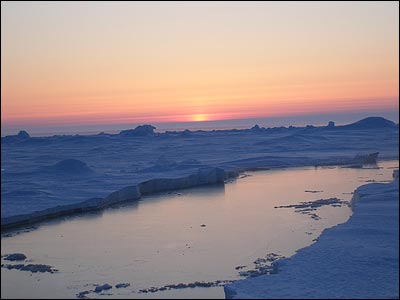Arctic ice thickness drops by up to 19 per cent
By Paul Eccleston
|
The thickness of ice in large parts of the Arctic dropped by as much as 19 per cent last winter, according to scientists. The average thickness fell by almost half a metre in some areas compared to the previous five winters.
After a slow downward trend since 2002 the rate suddenly increased after summer 2007 when the amount of ice dropped to its lowest level since records began. Following the record low, the amount of sea ice has recovered after cooler summer temperatures so the thinner ice cannot be blamed entirely on warmer Arctic conditions. Researchers from the Centre for Polar Observation and Modelling at University College London - part of the National Centre for Earth Observation - used satellite technology to measure sea ice thickness over the Arctic from 2002 to 2008. On average the winter sea ice in the Arctic is two and half metres thick. Its depth is calculated from the time it takes a radar pulse to travel from a satellite to the surface of the ice and back again. The team was the first to measure ice thickness throughout the Arctic winter, from October to March, over more than half of the Arctic, using the European Space Agency's Envisat satellite. Their research, reported in Geophysical Research Letters, showed that last winter the average thickness of sea ice over the whole Arctic fell by 26cm (10 per cent) compared with the average thickness of the previous five winters, but sea ice in the western Arctic lost around 49cm of thickness. This region of the Arctic saw the North-West passage in the summer of 2007 become ice free and open to shipping for the first time in 30 years. Dr Katharine Giles, who led the study said: "This summer's low ice extent doesn't seem to have been driven by warm weather, so the question is, was last winter's thinning behind it? "The western Arctic in the summer of 2007 saw the biggest changes in the amount of ice and this is where we saw the biggest changes in the thickness of the ice so it is hard to imagine that they are not connected. "We saw an average decrease of 10 per cent which is pretty dramatic." She said the loss of ice would reduce the Arctic's capacity to deflect sunlight and would lead to a larger areas of water which would absorb heat and produce warmer temperatures - leading to more ice melting. Dr Seymour Laxon, who also took part in the study, said: "Ice can simply melt and disappear or if the wind changes it can move and be piled up against the shore when you would expect it to become thicker but we saw no evidence of this and rather than getting thicker, the ice was thinner." Before this latest study, Christian Haas of the Alfred Wegener Institute for Polar and Marine Research in Bremerhaven, Germany, had discovered thinner ice in a small region around the North Pole but this is the first time scientists have been able to show that the ice thinning was widespread and occurred in areas of both young and old ice. An international team of scientists is to embark on a four year project to map the land forms of east Antarctica. They will use a DC-3 aircraft fitted with high resolution radar to measure the thickness of the ice and its composition. The scheme, jointly led by the University of Edinburgh and the University of Texas, hopes to uncover the hidden landscapes beneath the ice covered region which spans almost four million square kilometres - equivalent to half the size of the United States. Their findings will help forecast sea level changes and by analysing layers of ice thousands of years old will help show how the climate has changed. Professor Martin Siegert of the University of Edinburgh said: "This project will help us understand the behaviour of the largest ice sheet on Earth. "The data that we collect should provide a lot more detail of what caused past climate shifts, why there appears to be more ice loss from glaciers at present, and give us real clues to what may happen in the coming decades. "It will allow us to see for the first time the shape of the ice, and the land and lakes underneath it, and help us plan future research." |
